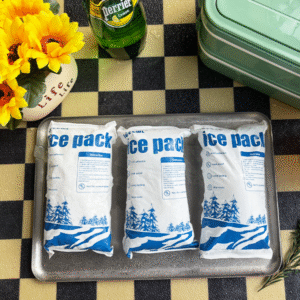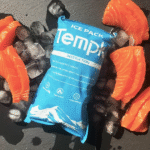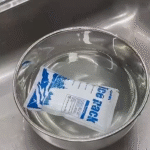Pack de glace carbonique Hazmat: Manipulation sûre, Conditionnement & 2025 Tendances
Expédition d'un hazmat dry ice pack isn’t as simple as throwing frozen bricks into a box. Because dry ice is the solid form of carbon dioxide, it sublimates into CO₂ gas and can displace oxygen in enclosed spaces. Ce guide montre how to package, label and ship hazmat dry ice packs safely while meeting DOT, IATA and USPS rules. You’ll learn why dry ice is classified as Class 9 matières dangereuses, how to choose the right container and how market trends in 2025 are reshaping the cold chain industry. Que vous expédié les vaccins, steaks or cell therapies, understanding these principles protects your cargo and keeps you compliant.
What is a hazmat dry ice pack and why is it regulated?
How do you package and label a hazmat dry ice pack to prevent accidents?
Which regulations apply to air, ocean and ground shipments in 2025?
What are the pros and cons of dry ice packs versus gel packs and phase change materials?
What are the latest market trends and sustainable innovations for dry ice in 2025?
How can you calculate the right amount of dry ice and reduce your carbon footprint?
What Is a Hazmat Dry Ice Pack and Why Is It Regulated?
Definition and classification: La glace sèche est un dioxyde de carbone solide. When it warms it Limères soudantes directly into gas instead of melting, producing volumes of CO₂. In transport this gas can build pressure inside a sealed box, or displace oxygen and create asphyxiation hazards. Because of these risks, regulators classify dry ice as a Classe 9 matières dangereuses diverses with proper shipping name “Carbon dioxide, solid” or “Dry ice” and UN 1845 numéro d'identification. Dry ice becomes a regulated hazmat when shipped by air or vessel; ground shipments within the U.S. are generally exempt but still must meet packaging rules.
Hazards explained:
Oxygen displacement: CO₂ is heavier than oxygen and can push breathable air out of an enclosed cargo hold, conduisant à la suffocation.
Pressure build up: Comme la glace sèche sublime, gas pressure can rupture a sealed container.
Cold burn risk: Le contact direct avec de la neige carbonique peut provoquer de graves engelures.
Due to these risks, carriers and regulators impose strict rules for handling hazmat dry ice packs. Understanding these rules helps you avoid fines and accidents.
Properties of Dry Ice and Pack Formats
Dry ice maintains an ultra cold temperature of –78,5 ° C (–109 °F). Contrairement à la glace d'eau, it creates no liquid; instead the only by product is gas. Dry ice containers are insulated boxes (often made from high density polyethylene or expanded polystyrene) that hold bulk blocks or pellets and include vents to allow gas escape. Dry ice packs are smaller pouches or wraps containing pellets or slices designed to fit around individual products and deliver targeted cooling.
Different formats deliver different performance:
| Format | Plage de température typique | Durée | Meilleurs cas d'utilisation |
| Large dry ice block | –78,5 ° C | Jusqu'à 72 h | Expéditions longues, bulk cargo |
| Dry ice pellets/nuggets | –78,5 ° C | 24–48 h | Quick cooling, processing lines |
| Dry ice slices/wraps | –78,5 ° C | 24–48 h | Customized fit, small parcels |
| Packs de gel | 0–10 °C | 12–24 h | Refrigerated meals, produire |
| Matériaux à changement de phase (PCMS) | 2–8 °C ou –20 °C | 24–96 h | Vaccins, produits biologiques nécessitant des plages de température étroites |
Choosing the right format depends on your payload, transit time and regulatory constraints.
La science de la sublimation
Sublimation means solid dry ice turns directly into gas without passing through a liquid phase. Because there’s no liquid, products stay dry—but the CO₂ gas must be vented to prevent overpressure. Proper ventilation is not just a good practice; it’s a safety requirement across all shipping modes. Containers should never be airtight; jerricans and steel drums are prohibited because they can explode.
How to Package and Label a Hazmat Dry Ice Pack
Exigences d'emballage
Regulators require that hazmat dry ice packs are packaged in sturdy, conteneurs ventilés. According to hazmat training resources, packaging must allow the release of CO₂ gas to prevent pressure build up. FedEx 2025 Dry Ice Job Aid warns against using steel drums or sealed plastic bags; plutôt, use high quality fiberboard, caisses en plastique ou en bois. If a plastic cooler is used, it must have holes or an open plug for ventilation.
A well insulated box with polystyrene foam can slow sublimation, but the foam must not be sealed airtight. Les États-Unis. Postal Service (USPS) also notes that boxes should permit gas release and conform to 49 CFR § 173.217. Pour le courrier de surface, weight limits are more generous; for air mail, USPS restricts each mailpiece to 5 lbs de glace sèche.
Key packaging tips:
Use durable outer boxes made of fiberboard, en plastique ou en bois.
Never place dry ice in airtight bags or metal drums.
Ajouter de l'isolation (Par exemple, polystyrène) but leave vent holes.
Ensure the container is strong enough for handling and stacking.
Weight Limits and Ventilation
International air transport rules limit the amount of dry ice per package to 200 kg. This applies to cargo or passenger aircraft. Pour les compagnies aériennes de passagers, individual travelers can bring up to 2.5 kg (5.5 lbs) of dry ice without additional paperwork. Exceeding this amount triggers a dangerous goods declaration and more stringent packaging requirements.
Ventilation is non negotiable: dry ice releases gas that must escape. Carriers like FedEx explicitly instruct shippers not to seal containers completely and to avoid steel drums or jerricans. Even high quality insulated boxes require vent ports to avoid explosions.
Marquage et étiquetage
Proper marking allows carriers and emergency responders to identify hazmat dry ice packs quickly. Shippers must place the following on the package surface:
Nom d'expédition approprié: «Glace sèche» ou «dioxyde de carbone, Solide". This name should appear near the hazard label.
Numéro de l'ONU: «Et 1845».
Poids net: The amount of dry ice in kilograms (1 kg = 2 lbs). The weight must be accurate to ensure compliance and help carriers calculate ventilation needs.
Classe 9 étiquette de danger: Une étiquette en diamant noir et blanc au moins 100 × 100 mm. N'écrivez pas à l'intérieur de la bordure en diamant.
Shipper and consignee names and addresses: These must be durably marked on the package.
Pour les expéditions d'air, une déclaration de l’expéditeur pour les marchandises dangereuses (DGD) may be required when dry ice accompanies dangerous goods. Lorsque la glace carbonique est utilisée pour refroidir des marchandises non dangereuses, no declaration is needed; plutôt, note the presence of dry ice on the air waybill.
Documentation Differences by Mode
Air (VOICI DGR): Packaging instruction 954 permet jusqu'à 200 kg of dry ice in a package and permits non UN packaging, provided venting is allowed. The shipper must include the proper shipping name, Numéro de l'ONU, and net weight on the package and may need to file a DGD for dangerous goods.
Océan (IMDG Code): Similar to air rules, packaging must be strong and vented. Documentation is always required, even if dry ice cools non dangerous goods. Marking includes the proper shipping name and UN number; net weight is not mandatory for ocean shipments.
Sol (49 CFR § 173.217): Dry ice is exempt from hazmat regulations when shipped by road or rail in the U.S., but packaging must still allow venting and the shipper must mark the package appropriately. USPS permits up to 5 lbs for air mail and more for surface mail, with clear “Surface Only” markings.
Triple Packaging for Biological Materials
When dry ice cools infectious substances or diagnostic specimens, triple packaging is mandatory: an inner leak proof receptacle, a secondary leak proof container with absorbent material, et une boîte extérieure solide. The outer box must display the dry ice hazard label and net weight. This system protects handlers and prevents leaks if the primary container breaks.
Hazmat Dry Ice Pack Safety and Handling Tips
Safe handling of hazmat dry ice packs protects workers and recipients. Follow these tips to minimize risks:
Équipement de protection individuelle (EPP)
Gants isolés: La glace carbonique peut provoquer des engelures. Always use thermal gloves when handling pellets or blocks.
Eye protection: Wear safety goggles to guard against splinters and contact burns.
Aprons or lab coats: Protect your clothing and skin from accidental contact.
Ventilation et stockage
Stocker dans des endroits aérés: Do not store dry ice packs in airtight rooms or vehicle trunks. Le CO₂ peut s'accumuler et déplacer l'oxygène.
Never seal containers: Always allow gas to escape through vents or partially open lids.
Évitez les espaces confinés: Do not enter small storage rooms or walk in freezers where dry ice is sublimating without testing oxygen levels.
Handling and Loading Procedures
Utilisez des pinces ou des cuillères: Avoid direct contact with dry ice pellets. Use tools to transfer them into containers or packs.
Load last: When loading a vehicle, add dry ice packs just before departure to minimize sublimation loss.
Surveiller la température: Use data loggers or thermal indicators to ensure the payload remains within the desired temperature range.
Disposal and Environmental Considerations
Laissez-le se sublimer: The safest way to dispose of dry ice is to leave it in a well ventilated area at room temperature until it turns into CO₂ gas. Ne jetez jamais de glace sèche dans les éviers, toilettes ou poubelles.
Empreinte carbone: Because most industrial CO₂ is fossil derived, sustainability is a growing concern. Consider hybrid cooling solutions or bio based dry ice to reduce emissions.
Regulatory Overview for Hazmat Dry Ice Packs in 2025
Understanding the regulatory landscape helps you avoid violations. Here is a concise overview of the key regulations:
| Regulation/Agency | Key Provisions | Ce que cela signifie pour vous |
| 49 CFR § 173.217 (POINT) | Dry ice regulated only by air and vessel; ground shipments exempt but must use vented packaging. | If shipping via highway or rail, you can use dry ice without hazmat certification but must mark the package correctly. |
| Réglementation IATA sur les marchandises dangereuses (VOICI DGR) | Instruction d'emballage 954 permet jusqu'à 200 kg de glace sèche par colis; requires proper shipping name, Et 1845, étiquette de danger, net weight and venting. | Pour les expéditions d'air, personnel de formation, prepare an air waybill note or DGD, and limit weight accordingly. |
| IMDG Code (Océan) | Requires vented, strong packaging; documentation is mandatory even when cooling non dangerous goods. | Always include shipping papers when using dry ice for ocean freight. |
| USPS Packaging Instruction 9A | Packages must permit gas release and conform to 49 CFR; for air mail, limiter la glace carbonique à 5 lbs and affix Class 9 label and “Carbon Dioxide Solid, UN1845” marking. | When mailing domestically, follow USPS weight limits and labeling rules; Le courrier international avec de la glace sec est interdit. |
| FedEx Dry Ice Job Aid (2025) | Prohibits steel drums or sealed plastic bags; mandates labeling and net weight; sets class 9 label dimension at 100 mm; instructs using fiberboard or plastic boxes. | When using FedEx, follow their packaging instructions; mark both shipper and recipient addresses clearly and use proper label sizes. |
Choosing the Right Hazmat Dry Ice Pack for Your Cargo
Assess Your Temperature Needs
Ultra cold cargo: Materials such as vaccines requiring < –70 °C should be shipped with dry ice blocks or combination packs. Dry ice provides ultra cold temperatures and is cost effective for short durations.
Refrigerated cargo (2–8 ° C): Des packs de gel ou des PCM suffisent; they are non hazardous and reusable.
Frozen cargo (–20 ° C): PCMs engineered to freeze at –20 °C maintain consistent frozen temperatures for 24–96 hours. They avoid the regulatory burden of dry ice.
Determine Duration and Transit Time
Expéditions courtes (< 72 h): Dry ice blocks or slices maintain deep freeze for 48–72 hours.
Expéditions moyennes (24–96 h): PCMs or hybrid systems combining dry ice and PCMs deliver stability for longer durations.
Expéditions longues (> 96 h): Active refrigeration units may be needed. These units use battery power or external electricity but cost more and add complexity..
Consider Reusability and Sustainability
Gel packs and PCMs are reusable, réduire les déchets et les coûts à long terme. La glace carbonique est à usage unique; once it sublimates, it’s gone. PCMs have higher upfront costs but lower regulatory burden and carbon footprint. Hybrid systems integrate PCMs with smaller amounts of dry ice, stretching hold times while minimizing hazmat handling.
Complexité réglementaire
Dry ice shipments require training, labeling and sometimes declarations, whereas gel packs and PCMs are mostly exempt. Evaluate your team’s capacity to handle hazmat training. If compliance is burdensome, PCMs may be a better choice.
2025 Trends and Innovations in Hazmat Dry Ice Packs
Dynamique du marché: Supply and Demand
The dry ice market is under pressure. Consumption has been growing around 5 % par année, but CO₂ supply increases only 0.5 % par année, leading to shortages and price spikes. During supply crunches, spot prices can surge by 300 %. Despite volatility, global demand continues to rise; le marché était évalué à USD 1.54 milliards en 2024 et devrait atteindre USD 2.73 milliards 2032 (7.4 % TCAC). La croissance est tirée par le transport de produits alimentaires, distribution de produits biologiques et de vaccins, and industrial applications.
Réponses de l’industrie aux pénuries
Manufacturers are addressing shortages by building localized production hubs and capturing CO₂ on site at facilities like food processing plants. Shippers are diversifying cooling strategies by combining dry ice with phase change materials and improving insulation to stretch each pound further. Long term supply contracts are replacing spot buying, ensuring critical sectors receive priority access during tight periods.
Sustainability Initiatives and Bio Based CO₂
Sustainability is becoming central. Food and pharma customers are pressuring suppliers to reduce the carbon footprint of dry ice. Since most industrial CO₂ comes from fossil sources, companies are exploring CO₂ biosourcé from bioethanol plants, where CO₂ released during fermentation can be captured and converted into dry ice. Au Royaume-Uni, the Ensus bioethanol plant provides an estimated 30–60 % de l’approvisionnement en CO₂ du pays. Cependant, geopolitical factors and trade policies threaten these operations, underscoring the fragility of CO₂ supply.
Rise of Alternatives and Hybrid Cooling
Alternatives to dry ice are gaining traction. Gel packs and PCMs hold narrow temperature bands for refrigerated or frozen goods. Active mechanical refrigeration (battery powered or external power) is used for long haul pharmaceutical shipments but increases cost. Improved insulation materials—such as vacuum panels and curbside recyclable foam—reduce the amount of dry ice needed and support hybrid solutions. Hybrid systems combining small amounts of dry ice with PCMs are being adopted to reduce reliance on CO₂ while maintaining cold chain integrity.
Tendances spécifiques au secteur
Nourriture & Boisson: Shippers are using thinner dry ice slices and pellets for rapid cooling on processing lines. They invest in high performance insulated boxes to reduce sublimation losses.
Pharmaceutique & Biotechnologie: Companies are testing barrier technologies to slow CO₂ gas release and implementing real time temperature monitoring to avoid supercooling. Hybrid shipments using PCMs for less temperature sensitive medicines are becoming popular.
Industriel & Soudage: Contractors invest in local pelletizing capacity to secure supplies and avoid being deprioritized during shortages.
Questions fréquemment posées
Q1: How much dry ice should I use in a hazmat dry ice pack?
The exact amount depends on your payload size, desired temperature and transit duration. En règle générale, allocate 5–10 lbs of dry ice per 24 heures of transit for small packages. Use insulated containers to minimize sublimation losses. Pour les expéditions dépassant 200 kg, split the load into multiple packages to stay within IATA limits.
Q2: Can I ship dry ice with non hazardous items like frozen steaks?
Oui, dry ice is often used to ship frozen food. When cooling non dangerous goods, you don’t need a dangerous goods declaration—just mark the package with the proper shipping name, Et 1845 et poids net. Ensure the container vents CO₂ and follow airline or carrier weight limits.
Q3: Is dry ice allowed in ground shipping?
Dry ice is regulated only by air and vessel; ground shipments in the U.S. are generally exempt. Cependant, packaging must still allow venting and the package should be marked. USPS allows more than 5 lbs for surface transportation, but air mail is limited to 5 lbs.
Q4: Are reusable dry ice packs better than single use?
Dry ice itself is inherently single use because it sublimates. Cependant, you can reduce waste by using durable insulated containers and combining dry ice with PCMs that are reusable. This hybrid approach lowers overall CO₂ consumption and simplifies compliance.
Q5: What’s the difference between a hazmat dry ice pack and a gel pack?
A hazmat dry ice pack uses solid CO₂ to maintain –78,5 ° C et est classé comme dangereux; it requires labeling and weight limits. A gel pack uses a water based gel to keep products at 0–10 °C and is non hazardous. Les packs de gel sont réutilisables, easier to handle and suited for chilled goods.
Practical Tips and User Scenarios
Choosing the Right Packaging Scenario
Ship vaccines requiring ultra cold temperatures: Use a hazmat dry ice pack with large blocks to maintain –70 °C for 48–72 hours. Pre condition the container in a freezer and fill any empty space with additional dry ice slices. Attach a data logger to monitor temperature.
Send gourmet desserts or frozen meat: For same day or overnight delivery, wrap the product in an inner insulated bag and surround it with dry ice pellets. Ensure the box vents gas and mark it with “Dry Ice UN 1845” and net weight. You do not need a DGD when shipping non dangerous goods.
Transport biological samples: Use triple packaging and a combination of dry ice and PCMs to stabilize temperature. Clearly label the outer box with the infectious substance category, dry ice weight and hazard class. File a DGD if required by your carrier.
Domestic surface shipping via USPS: Keep the dry ice below 5 lbs for air transport or mark “Surface Only” if sending via ground. Include the contents description and weight on the address side of the package.
Étude de cas: Gene Therapy Shipment
Vrai exemple: A biotech firm needed to transport gene therapy vectors requiring temperatures below –60 °C. They used a hazmat dry ice pack with blocks and pellets layered together. By preconditioning the container and filling empty spaces with custom dry ice slices, they kept the temperature between –65 °C and –70 °C for 72 heures. Real time monitoring ensured product integrity without supercooling, and proper labeling and documentation prevented delays.
Glace sèche vs. Packs de gel vs. PCMS: Qui est le meilleur?
The table below summarizes the differences among dry ice, packs de gel et matériaux à changement de phase. This helps you decide which refrigerant fits your shipment.
| Méthode de refroidissement | Plage de température | Durée | Classe de danger | Réutilisabilité | Meilleurs cas d'utilisation |
| Glace sèche (Co₂) | –78,5 ° C | 48–72 h | Classe 9 dangereux | Usage unique | Envois ultra froids: vaccins, vecteurs de thérapie génique, viande surgelée |
| Packs de gel (À base d'eau) | 0–10 °C | 12–24 h | Non dangereux | Réutilisable | Aliments réfrigérés, kits de repas, produire |
| Matériaux à changement de phase (PCMS) | –20 °C ou +2–8 °C | 24–96 h | Non dangereux | Réutilisable | Vaccins, produits biologiques nécessitant des plages de température étroites |
| Hybride (Glace sèche + PCM) | –20 to –70 °C | 48–96 h | Patrie (due to dry ice) | Reusable PCM portion | Long shipments requiring extended hold time; réduit la quantité de neige carbonique nécessaire |
Outils interactifs et engagement des utilisateurs
Creating an engaging experience helps users apply what they’ve learned and reduces bounce rate. Here are two interactive ideas you could implement on your website:
Calculateur de quantité de glace carbonique: An interactive widget where users enter the payload weight, plage de température et temps de transit souhaités. The calculator then estimates how many pounds of dry ice they need and suggests whether to use blocks, pellets or a hybrid system. This tool helps avoid over or under packing and ensures compliance.
Liste de contrôle de la conformité: A self assessment quiz that asks users about their shipment (mode, poids, contenu). It outputs a customized checklist of packaging, marquage, exigences en matière de documentation et de formation. This encourages readers to engage with the content and share it with colleagues.
Résumé et recommandations
Principaux à retenir: Expédition d'un hazmat dry ice pack requires a combination of sturdy, emballage ventilé, clear labeling and adherence to regulations. La glace sèche est une classe 9 hazardous material because it sublimates into CO₂ gas and can displace oxygen. Les colis doivent être aérés, marked with the proper shipping name, Et 1845, poids net et classe 9 étiquette. IATA rules limit dry ice to 200 kg par forfait, while USPS allows only 5 lbs in air mail. Gel packs and PCMs provide non hazardous alternatives for higher temperature ranges. Market trends show that CO₂ supply shortages, sustainability pressures and hybrid cooling methods are reshaping the cold chain industry.
Prochaines étapes réalisables:
Évaluez votre charge utile: Déterminez la plage de température requise, duration and sensitivity of your goods.
Sélectionnez le bon réfrigérant: Utilisez de la glace sèche uniquement lorsque cela est nécessaire; consider gel packs or PCMs for chilled cargo.
Follow packaging rules: Utiliser ventilé, durable boxes, avoid airtight containers and include all required markings.
Formez votre équipe: Provide hazmat training for staff who pack, label or document dry ice shipments.
Surveiller les tendances: Stay informed about CO₂ supply and sustainable innovations; consider hybrid systems to reduce your carbon footprint.
Appel à l'action: Prêt à optimiser vos expéditions sous chaîne du froid? Assess your current packaging process and consider implementing a dry ice calculator or compliance checklist on your website. Proper planning and adherence to the guidelines above will keep your cargo safe, compliant and competitive in 2025.
À propos du tempk
Tempk is a leader in reusable, eco friendly cold chain solutions. Our team combines material science with years of logistics experience to develop insulated boxes, packs de gel, matériaux à changement de phase et packs de glace sèche pour matières dangereuses that meet DOT and IATA standards. We focus on reducing waste through durable packaging and exploring bio based CO₂ sources for dry ice. Our solutions are designed for food, expéditions pharmaceutiques et biotechnologiques, ensuring temperature integrity from factory to doorstep.
Entrer en contact: Consult our experts to select the right packaging for your shipment and learn how our hybrid systems can improve efficiency and sustainability.
























